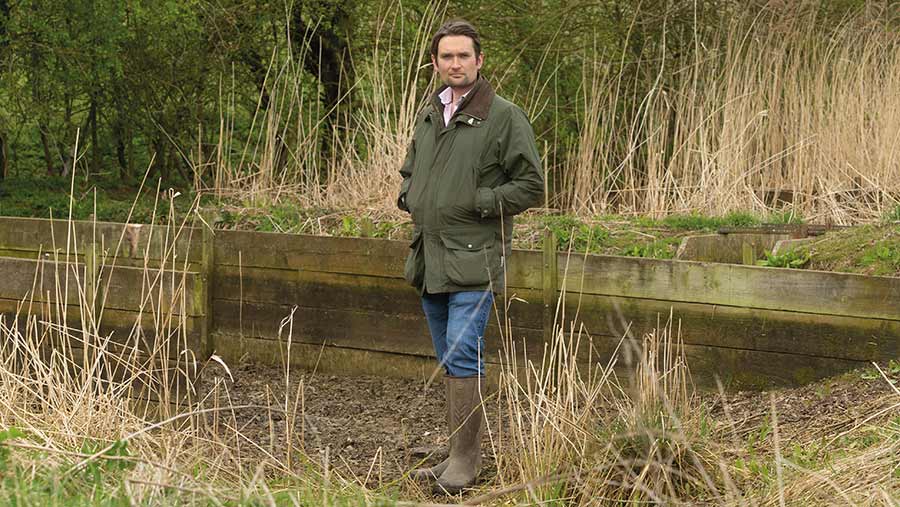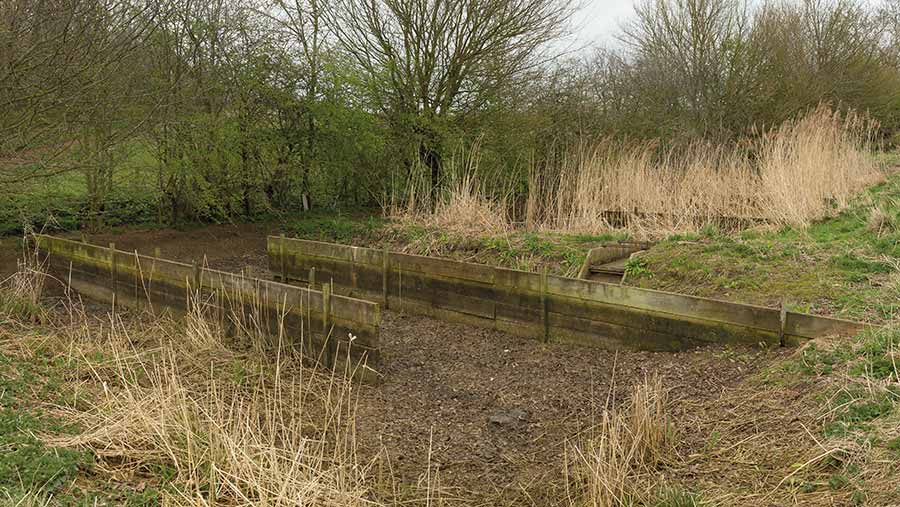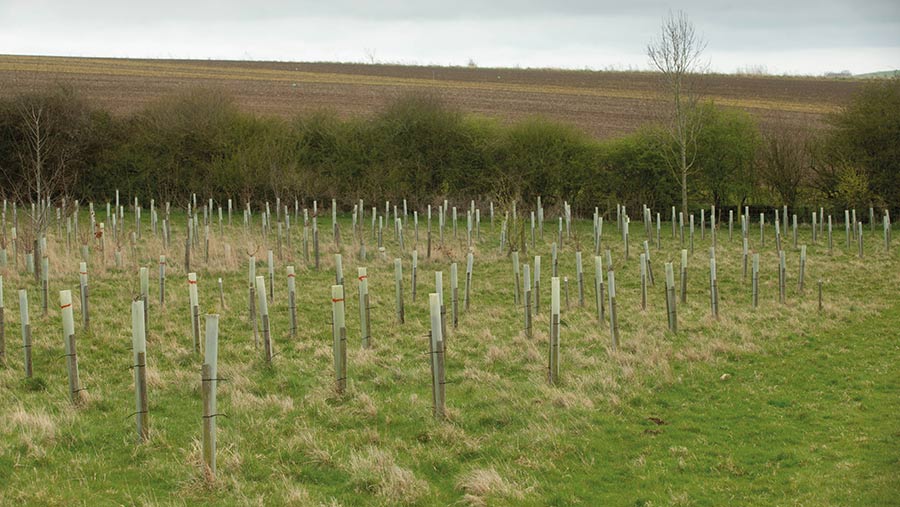How natural capital is thriving at pioneering farm
A working experimental farm in the small Leicestershire village of Loddington is developing groundbreaking natural capital schemes that benefit farmers.
The Game and Wildlife Conservation Trust’s Allerton Project has been at the forefront of practical, agri-environment research since 1992.
Its natural capital trials are key in helping growers and livestock producers transition towards a more sustainable way of farming.
See also: What farmers can do to unlock the value of natural capital
Farm facts: Loddington Estate Farm
- Land size: 318ha
- Arable 253ha
- Pasture 29ha
- Woodland 18ha
- Annual rainfall: 600-700mm
- Soil: heavy clay
Joe Stanley, Allerton Project head of training and partnerships, says the 320ha commercial farm aims to identify management practices that deliver multiple benefits.
“Our work covers natural capital accounting, agri-environment schemes and regenerative farming systems.
“This includes improving soil health, water quality, woodland and environmental habitats to increase biodiversity, while building farmland resilience.”

Joe Stanley © Tim Scrivener
In the 30 years since the project was set up, Allerton has shown how productive farming can work alongside nature.
Bird species, mammal populations and invertebrate numbers have all improved, says Mr Stanley.
Many endangered, Amber and Red List bird species have recovered here at five to 10 times the rate seen on other commercial farms across the region.
Moth numbers on the estate are increasing, bucking the national trend. Brown hare populations are thriving, too.
Calculating biodiversity
The Allerton Project has seen researchers develop a system capable of measuring biodiversity by assessing its quality, condition and extent.
This has enabled the Loddington Farm Estate to calculate a so-called biodiversity baseline – a potentially vital advance for the future of UK farming.
Mr Stanley suggests this area of work will be important for farmers who will need to establish biodiversity baselines for their own businesses.
Future funding schemes and natural capital trading will be based on being able to demonstrate incremental improvements to assets.
From a legal perspective, companies will want to know exactly what they are getting in exchange for their investments.
Farmers will have to be able to demonstrate and quantify accurately what improvement has been achieved, so the system will provide an important foundation.
From a farmer trading viewpoint, knowing what potential is on-farm will allow a better evaluation and more careful management of assets over the long term, says Mr Stanley.
As well as the biodiversity calculation, the Allerton Project has a range of practical trials under way.
These include sediment traps, the development of a Hedgerow Carbon Code, agroforestry trials and a reduced tillage comparison.
Sediment traps
Climatologists are predicting more frequent, heavy rainfall, adding to already serious risks of water run-off and soil erosion from field surfaces.
Losses from certain soil types can amount to many tonnes from a single field each year, says Mr Stanley.
The losses reduce soil fertility and production capabilities, and can lead to nutrient pollution and sedimentation of watercourses.
Farmers and growers, therefore, face an increasing threat of reduced production and potentially fines or payment scheme penalties for pollution.
To investigate practical measures, the Allerton Project has developed and studied sediment traps, which are sited in watercourses at the field edge.
The plan was to slow the waterflow, allowing time for soil to separate out and settle by widening ditches into ponds.
The nutrient-rich sediment could then be dug out and reclaimed, and the water quality was improved with the removal of the nitrates and phosphates.
To ensure the trial represented a range of soil types, traps were built on Loddington’s heavy clay and two further sites in Cumbria – one on sand, and a second on a silty loam.
Results differed hugely – the higher the sand fraction, the greater the amount of settlement and capture, Mr Stanley notes.
At Loddington, the fine particles of the clay remained dispersed among the pond water, limiting the amount of soil that was captured.
But the pond traps on sandy soil retained tonnes of sediment. As much as 39t of soil was reclaimed in a single year on the sand, while the silty loam retained 18t. Loddington, in contrast, was just 0.3t in the same year.
Nevertheless, the sediment traps proved it was possible to retain valuable natural capital in the form of reclaimed soil.
The traps could also be monetised by growers in financial deals with regional utility companies, which may view them as a cost-effective way of improving quality.

© Tim Scrivener
Hedgerow Carbon Code
Allerton was selected by the government to develop a Hedgerow Carbon Code with funding from Defra’s Natural Environment Investment Readiness Fund.
The Hedgerow Carbon Code project is at an advanced stage and expected to be useable by 2023.
It has huge national potential for enabling farmers to increase the amount of carbon storage and trade the associated credits.
In England, there are more than 400,000km of managed hedgerows and a further 145,000km are derelict or declining.
This represents a valuable resource for carbon capture because hedgerows have almost as much biomass in their root structure – about 40% of the total – as they have above ground at 60%.
The total amount of biomass and the three-dimensional structure means hedgerows sequester carbon at twice the rate of woodland.
Estimates suggest England’s hedgerows store about 9m tonnes of carbon which would currently be worth about £63m in credits, says Mr Stanley.
Hedgerows grow rapidly and doubling their height and width would equate to a 200% increase in the amount and value of the carbon stored.
As part of the code, Allerton has developed a matrix that attaches values to the length, width and height of a growing hedgerow.
It also accounts for cutting, laying and coppicing regimes. The matrix will eventually account for the value of cuttings that increase soil organic matter and apply a value as a biomass energy source.
There is then no disincentive to lay or trim the hedge. Once in place, the scheme will be audited and accredited by a verification body in a similar system to the Woodland and Peatland Codes.
Agroforestry
Allerton has been investigating the use of woodland combined with livestock production on the Loddington Estate Farm.
The aim is to assess how to introduce trees that provide wildlife habitats, capture carbon and improve water management while maximising livestock growth.
A 5ha plot was planted in 2016 at different densities. Two plots were planted at 100 trees/ha, representing a relatively high agroforestry density.
Others were planted at 400/ha to represent the lowest permissible density for open woodland with government funding.
The remainder was planted at 1,600/ha – the maximum density normally funded under woodland creation.

© Tim Scrivener
“We quickly learned that the densities and the associated availability of grazing between the trees make a significant difference,” Mr Stanley says.
Initial results showed that stocking rates and grass growth had to be carefully matched, especially in dry spells when sheep will readily turn to graze young trees, he explains.
Reduced tillage
Allerton has partnered with Syngenta to set up a conservation agriculture trial comparing direct drilling with ploughing and the effects on profit and wildlife.
The five-year, five-crop rotation trial took place on two sites: light land, in Lenham, Kent, and heavy clay at the Loddington site.
Now in its fifth year, results are showing that direct-drilling can benefit wildlife and reduce emissions while raising net profits.
Wildlife and emission changes
Both sites saw bird sightings almost double – Lenham was up 105% and Loddington increased by 90% versus inversion tillage.
Earthworms were used as an indicator of soil health, which improved under direct-drilling. Soil greenhouse gas emissions fell by 16-17% in a direct-drilling scenario.
Both farms saw their overall carbon footprint reduce by about 10% a hectare.
Fuel use dropped dramatically by 65% on the sandy soil of Lenham and 50% at Loddington.
This had a beneficial effect on operational costs, which fell by 8-10% – although crop establishment dropped by 3% at Lenham and 8% at Loddington, with roughly the same percentage declines in yields.
However, net profits rose by 5% at Loddington and 18% at Lenham when the reduced costs of time and fuel were included.
Fit for future farm business guide
In addition to the research work, the Allerton Project hosts up to 3,000 visitors each year from the public, policymakers, farmers and schoolchildren.
This spring, it is also offering training as part of a partnership between Defra, the Game and Wildlife Conservation Trust and National Federation of Young Farmers’ Clubs (NFYFC).
The Fit for the Future programme centres on an online package of guides.
But it also includes visits to the Loddington Estate Farm, where young farmers can learn about topics including conservation agriculture, integrated pest management and agroforestry.
The final visit is scheduled to take place on 21 May, and clubs are encouraged to get in touch with NFYFC if interested.
